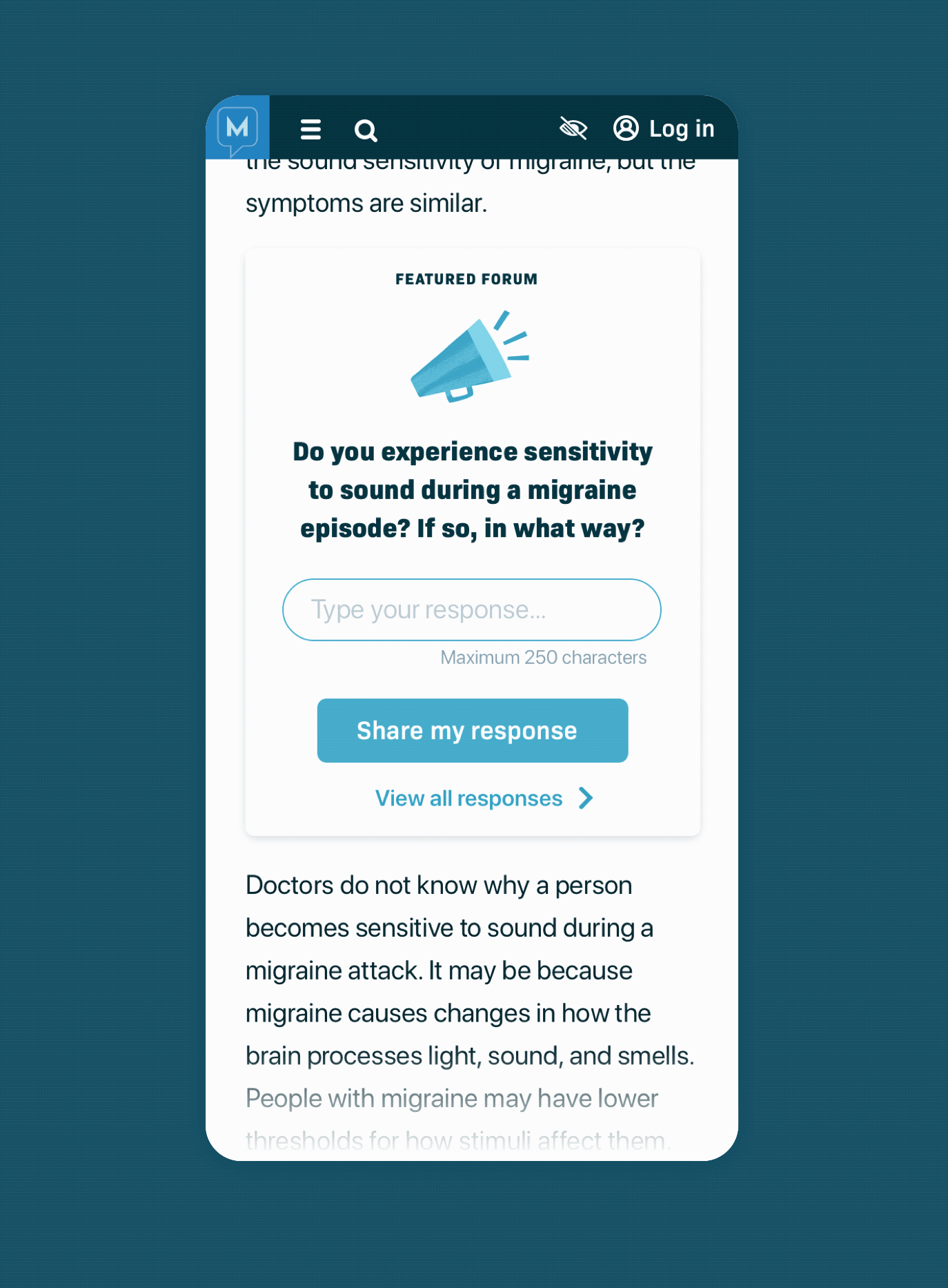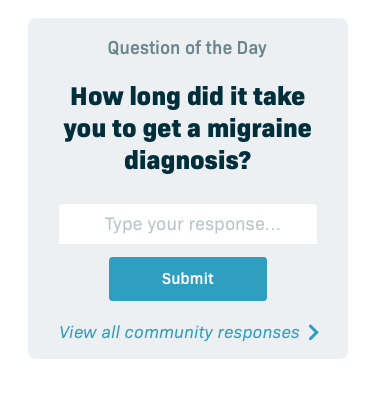Migraine.com
The Ask. Create a new engagement feature that converts organic passive users to active registered users.
Role. UX Lead
Details. Research. Wireframing. User testing. UI design.
Migraine.com is a website dedicated to providing information and resources for individuals suffering from migraines.
In addition to informational articles and content hubs, the site features a robust community forum where individuals can connect and share their experiences with others who have similar conditions. At the onset of this project, the forums were not easily discoverable on the website, and most users who found the site organically were only reading articles and dropping off quickly. This resulted in low engagement and user registration rates, which was an ongoing business problem we needed to solve.
01. The Problem
Awareness.
Users who were not aware of the forums were missing out on the opportunity to connect with others who had similar experiences and the ability to receive support from the community.
02. The Challenge
Make the forums more discoverable.
We needed to make users aware that there was a vibrant and active community on the site and encourage them to engage with forum threads that may interest them.
03. Discovery and Research
Static house ads were not engaging.
We started with preliminary research of the current forum drivers on informational articles across Migraine.com, and focused on pulling click-through rates for house banner ads that attempted to drive users to the forums. We found that the average click-through rate for these ads was very low at only 1.1%.
User awareness was a big problem.
To gain a better understanding of user needs, the team conducted an annual "Tell us how we're doing" survey across the site. The survey found that users who were aware of the forums found them to be useful and visited them repeatedly. However, the majority of those surveyed were not even aware that forums existed on the site, indicating a significant gap in awareness and engagement.
We found a huge market gap.
Additionally, the team conducted a competitive analysis and found that having robust forums was a crucial market gap that Migraine.com could fill. We already had a great forum platform, we just needed users to find it. This led the team to focus on building a forums driver that would increase awareness and engagement within the forums.
Conclusions.
Overall, the research and analysis conducted by the team provided valuable insights into user needs and pain points. The low click-through rate of existing forum drivers and the lack of awareness among users indicated a need for a more effective and visible way to promote the forums.
The existing driver to forums on the site was a static house ad with very low click-through rates.
04. Solving for User Needs and Business Goals
Engagement is key.
The new feature should be designed to entice the user to visit the forums and engage with the community. This will be achieved by making the feature something to engage with, rather than just a static banner ad.
Boosting registration.
To contribute to the forums, users will be required to create an account. This will increase the number of registrations overall for the site, achieving the ongoing business goal of increasing user registrations and active engaged community members.
05. Ideation and Brainstorming
Preliminary sketching.
The brainstorming phase for the forums driver involved testing multiple ideas to determine the best approach. Various iterations of how to solve for the problem ensued, with four different versions of possible forums drivers ultimately making it to the final rounds. These concepts included a “Fill in the Blank” engagement feature, “Question of the Day" concept, “Patient asks,” and “Connect with a Patient Like You” driver.
The “Patient asks…” and “Connect with a Patient Like You" was tabled early on due to legal concerns around posting user-generated content and photos. The team decided to explore this feature in the future with more legal guidance.
Theorizing and testing.
We ended up testing the "Fill in the Blank" driver against a "Question of the Day" driver, and theorized that open-ended questions require more critical thinking than a fill in the blank prompt, which only requires a word or a phrase to complete the thought, resulting in less user fatigue. In some preliminary user testing, we placed both types of prompts on established social media platforms and found that both concepts received similar reactions and comments. Based on this result, and since the concepts were so similar, the team made the final decision to move forward with both, but combining them to fit a single concept. One heading, with flexibility to pose a question or include a fill in the blank, and have the heading read “Question of the Day”.
06. User Testing and Results
A major wording change.
Next steps involved user testing to determine if our initial ideas were working. One consideration was what happens after the user submits their response? A working prototype was created, and a simple test was performed among participants. The results showed that most users preferred a success screen with the option to visit the forum thread, which would potentially yield more traffic to the thread.
Another key finding from user feedback was that the title of the driver, "Fill in the Blank," confused community members. The change to "Featured Forum" was made, and additional testing showed no confusion. Additionally, most users weren't happy with the interruption of the feature mid-article and asked that the feature be placed further down the page or entirely at the end of the article they were reading. To satisfy both business and user goals, a compromise was reached to place the driver ¾ of the way down the page instead of in the middle.
Overall, user feedback was instrumental in shaping the final design of the forums driver feature, ensuring that it was both user-friendly and effective in driving engagement.
The existing driver to forums on the site was a static house ad with very low click-through rates.
07. Final Design
Decreasing disruption, and focusing on integration.
The user testings yielded pivotal results that ultimately dictated major decisions in the final design process. Starting with overall design, since users expressed a concern with feeling that the engagement feature was disruptive, or pulling them away from the content on the page, I wanted to be sensitive to these concerns and aimed to design the feature to “blend in” to the article. To achieve this, I opted for a subtle shadow around the feature instead of the gray box in previous versions which makes it easier for the eye to either skim over or jump in and engage. This also solved a potential business problem of the feature looking like an advertisement, or potential third party information versus an engagement feature hosted by Migraine.com.
Keeping the user informed with character counts and RED LINES.
We also decided to implement a character count, drawing from concerns from Migraine.com’s community leads that users could potentially leave pretty wordy responses, and this feature’s goal was to be a quick engagement on the page that was a low lift to the user. We also didn’t want to abruptly cut the user off from typing, so we decided to implement a live countdown, and once the limit was reached, the feature will allow the user to finish their thought and keep typing, but letting the user know that this is not permissible in three ways: the character count wording changing to “over limit”, the text input box color changing from blue to red, and the submit button becoming disabled.
07. Final Results
The importance of user-focused design.
Overall, the redesign of the forums drivers on Migraine.com has been a success, resulting in increased engagement and forum awareness among users, higher registration success rates, and positive feedback. These results demonstrate the importance of user-centered design and the value of incorporating user feedback into the design process.
After the forum drivers went live, Migraine.com saw a 40% increase in user engagement with the forums, as well as a 20% increase in community registration rates. These results demonstrate the effectiveness of user-centered design and the importance of incorporating user feedback into the design process.
The success of the redesigned forums drivers can also be seen in the feedback from the community. Many users have expressed their appreciation for the new design and the increased opportunities for engagement and interaction with other community members. The positive feedback has encouraged the Migraine.com stakeholders to continue to prioritize user feedback and to make further improvements to the site to meet the needs of its users.











